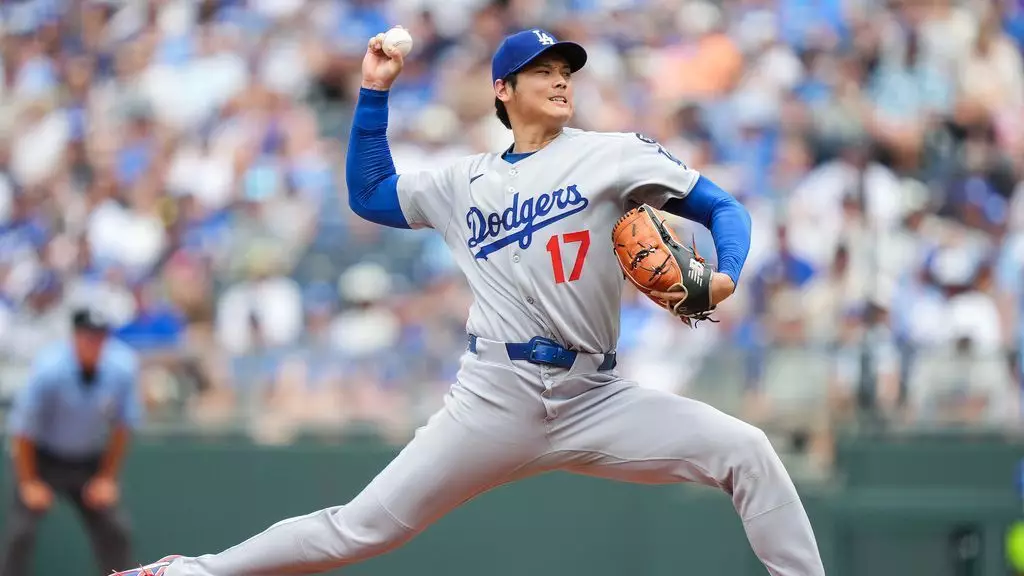Shohei Ohtani’s recent outing against the Kansas City Royals offers a striking glimpse into a remarkable career navigating the challenges of injury and dual-role demands. Clocking a blistering 101.7 mph, Ohtani’s fastball was the fastest pitch of his Major League career as he delivered two innings for the Los Angeles Dodgers—his first multi-inning start this season. Against the backdrop of his recovery from Tommy John surgery, this performance was more than just a statistical milestone; it symbolized his resolute journey back to dominance on the mound.
It’s easy to overlook how gleaming velocity numbers represent nuanced improvements in health and command. Ohtani’s ability to consistently deliver first-pitch strikes to every one of the seven batters he faced—and to finish with 27 pitches, 20 being strikes—showcases a pitcher who’s not only regaining his arm strength but rebuilding refined control. For a player who has alternated between pitching and hitting at baseball’s highest level, these details matter immensely, especially when considering the wear and tear such dual roles inevitably impose.
More Than Just Speed: Commanding the Game
Ohtani’s velocity grabbed headlines, but the game narrative underscores something deeper—a mature understanding of pitching strategy. The pitcher’s efficient management of batters, mixing a devastating fastball with precise sliders and employing situational pitching, like inducing a double play after an 0-2 count, highlights a cerebral approach rather than relying solely on raw speed. His ability to strike out a promising rookie, Jac Caglianone, with an 89 mph slider illustrates this balanced attack and indicates a pitcher who knows how to vary his arsenal effectively.
Dodgers manager Dave Roberts, a seasoned strategist, noted Ohtani’s ability to maintain control even while throwing triple digits, signaling that the player’s competitive edge remains intact without succumbing to recklessness. This blend of confrontation and control is essential in post-injury pitching, where overexertion can lead to setbacks. Ohtani’s measured aggression on the mound, combined with his physical performance, serves as a testament to his professionalism and understanding of his own limits.
The Marathon of Recovery: Patience and Progress
It’s crucial to contextualize this performance within Ohtani’s larger recovery timeline. He missed the entire previous Major League season—the first after joining the Dodgers—due to Tommy John surgery, one of baseball’s most severe arm injuries. Historically, such recoveries hover between 12 to 18 months, and the transition back to high-level competition is far from linear. Ohtani’s limited pitching schedule, beginning with opener roles and gradually building to multi-inning appearances, reflects an intentional, cautious approach to restore durability and effectiveness.
Moreover, his pitching career is complicated by his unprecedented role as a two-way player. Balancing energy and focus between hitting, fielding, and pitching segments demands not just physical resilience but extraordinary mental acuity—a factor sometimes underappreciated by the casual observer. It’s clear Ohtani and the Dodgers are navigating a finely tuned regimen that preserves his unique talents without sacrificing longevity.
Legacy in Fastballs and Beyond
While the recent 101.7 mph pitch stands as his fastest in Major League Baseball, it is notable that Ohtani’s personal best velocity was documented at 102 mph during the 2023 World Baseball Classic—a moment that vividly illustrated his elite status on a global scale. His ability to throw overpowering fastballs is not just a hallmark of pace; it’s part of a psychological arsenal that unnerves hitters, as echoed by Vinnie Pasquantino’s candid remarks on encountering Ohtani’s hardest pitches multiple times.
This psychological element—intimidation through velocity—is paramount in Ohtani’s pitching success. Opponents constantly anticipate his explosive delivery, yet he couples power with tactical pitching selections, making him exceptionally difficult to predict and counter. His approach exemplifies the modern evolution of pitching, where velocity and finesse coexist.
Shaping the Future While Respecting Today’s Limits
Despite ongoing success at the plate—boasting 29 home runs this season as the Dodgers’ primary designated hitter—Ohtani is pragmatic about his physical state. His decision to skip the Home Run Derby reaffirms this mindset, acknowledging that certain competitive opportunities, while glamorous, might compromise his carefully managed workload.
This level of self-awareness is vital for prolonging an elite career, especially one as complex as Ohtani’s. It demonstrates a player not consumed solely by short-term spectacle but dedicated to sustained excellence. In balancing his roles and making strategic choices, Ohtani continues to astonish, redefining what it means to be a two-way player in the contemporary game.
In an era where specialization often dictates athlete development, Ohtani’s perseverance and adaptability stand as an inspiring narrative of resilience. His recent outing is not just a display of speed but a compelling chapter in a career defined by exceptional talent and extraordinary determination.


Leave a Reply